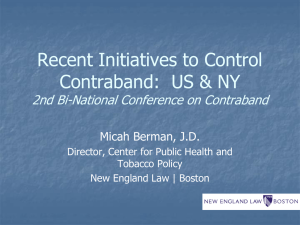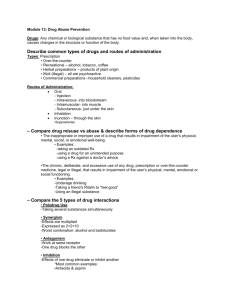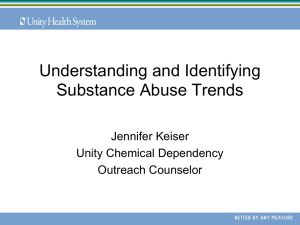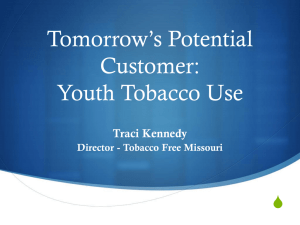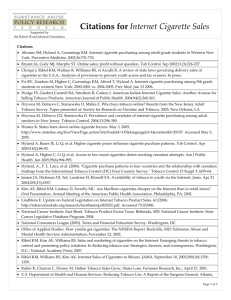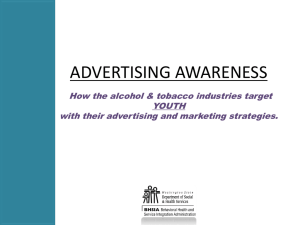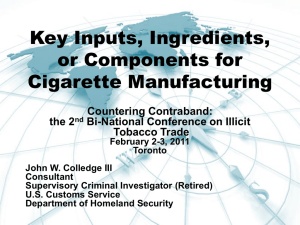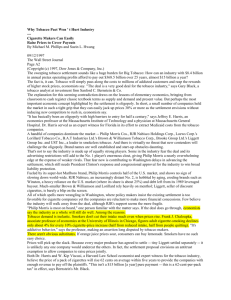A Brief History of Tobacco
advertisement
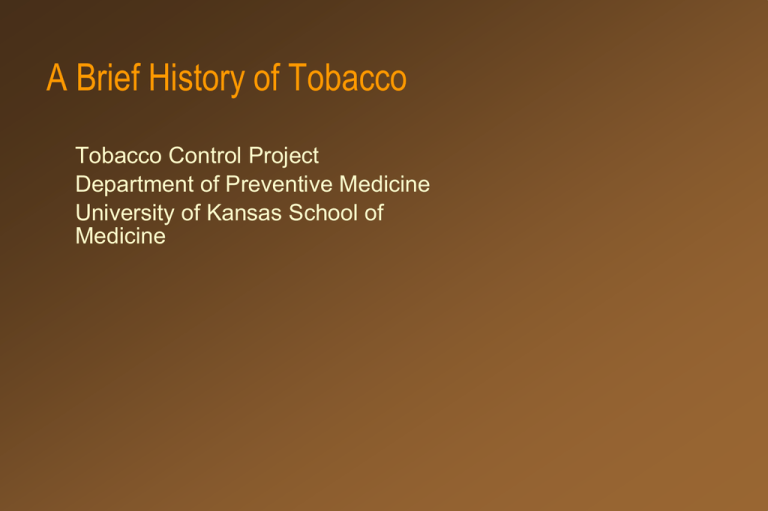
A Brief History of Tobacco Tobacco Control Project Department of Preventive Medicine University of Kansas School of Medicine Cigarettes are Sublime? “Warning smokers of the dangers entices them more powerfully to the edge of the abyss, where, like travelers in a Swiss landscape, they can be thrilled by the subtle grandeur of the perspectives on mortality opened by the tiny terrors in every puff. Cigarettes are bad. That is why they are good - not good, not beautiful, but sublime.” Klein, Richard. (1993). Cigarettes are Sublime. Durham: Duke University Press. 1492-1800 Production Use Puffed, chewed, Indigenous peoples snorted, drank in Americas juice, applied as Spain used cigars, a paste papaletes Air or wood-fire cured for dark, strong tobacco Policy Legal tender in some countries Hated but taxed in England France dev. cigarette At times forbidden in Russia, India, Most used chew Turkey, Persia tobacco in U.S. Ford, Barry. (1994). Smokescreen. Perth, Australia: Halcyon. Early Anti-tobacco Marketing? “A custom loathsome to the eye, hatefull to the Nose, harmfull to the braine, dangerous to the Lungs, and in the black stinking fume thereof, neerest resembling the the horrible Stygian smoke of the pit that is bottomlesse.” King James I,. (1604) A Counterblaste to Tobacco, as cited in Ford, Barry, (1994). Smokescreen. Perth, Australia: Halcyon. 1801-1900 Production Use · New mild strains developed · Flue curing made tobacco inhalable Policy · Penninsular, Crimean · Lucy Gaston wars spread use of fought “cigarette “cigarillos” in Europe face” · Tobacco tax financed Civil & SpanishAmerican Wars · Bonsack Machine · Civil war spread · 1900: 3 states 70,000 cigs/day cigarette use in U.S. ban cigarette sales · American Tobacco · 1900: 1/3 tobacco Co. monopoly users smoked in U.S. Ford, Barry. (1994). Smokescreen. Perth, Australia: Halcyon. 1901-Today Production · 1913: 10 billion cigarettes made · 1949: 393 billion cigarettes made Use · WW I spread use · 1922: cig smokers outnumbered pipe smokers, chewers Policy · Early 1900’s: Industry-backed minimum ages · 1965: Labeling act · 1950’s: filtered · 45% smoked in 1949 · 1967: FCC ruling cigarettes · Virginia Slims, Silvas · 1970: Hearings spurred women’s use on advertising · ‘50’s or ‘60’s nicotine was “free- · 25% now smoke · 1990’s: Liability based” w/ammonia claims Kluger, Richard. (1996). Ashes to Ashes. New York: Knopf; Ford, Barry. (1994). Smokescreen. Perth, Australia: Halcyon. Tobacco Was Decidedly Less Cool in the ‘80’s “Do you mind if I smoke?” “Not at all! Do you mind if I fart?” Steve Martin Missed Opportunities? 1906 Food and Drug Act 1966 Fair Labeling and Packaging Act 1970 Controlled Substance Act 1972 Consumer Product Safety Act 1976 Toxic Substances Act Kluger, Richard. (1996). Ashes to Ashes. New York: Knopf Perspectives on the Problem It’s an individual choice Children must be protected Smokers are addicted Smoking is immoral or deviant Smoking is disgusting All nonsmokers must be protected Smoking is sublime Adapted in part from Rabin, Sugarman, Eds. (1993). Smoking policy: Law, politics, & culture. New York: Oxford
